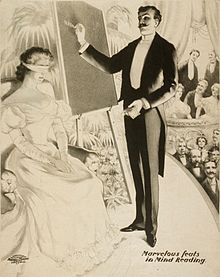Mentalism

Mentalism is a performing art in which its practitioners, known as mentalists, use mental acuity, cold reading, warm reading, hot reading, principles of stage magic, and/or suggestion to present the illusion of mind reading, psychokinesis, extra-sensory perception, precognition, clairvoyance or mind control. Hypnosis is also included in this category.
Explanation
Mentalism is similar to stage magic, featuring some of the same basic tools, principles, sleights and skills in its performance.[1] Some performers add stage hypnotism to the mix.
Much of what the mentalist does in his or her act can be traced back directly to tests of supernatural power that were carried out by mediums, spiritualists and psychics in the 19th Century. However, the history of mentalism goes back even further. One of the earliest recorded performances of a mentalism act was by diplomat and pioneering sleight-of-hand magician Girolamo Scotto in 1572.
Two tests still in general use today are the book test and the living-and-dead test. In the former, a book is chosen at random by an examiner (usually a member of the audience) and opened at a random page. The examiner would then concentrate on a word, sentence or paragraph of his or her choice. If the mentalist can discover the thought-of word(s), apparently using only "mental powers", then he passes the "test." In the living-and-dead test, the name of a deceased person(s) is mixed in with the names of people still living, all written on identical slips of paper. Apparently using mental powers alone, the mentalist must separate the living from the dead.
Styles of presentation can vary greatly. A few performers, in the mold of Uri Geller, or James Van Praagh, claim to actually possess supernatural powers such as telepathy, clairvoyance, precognition, or telekinesis. There remain some people who believe that Geller and similar practitioners are actually demonstrating supernatural powers. However, this belief is disputed by scientists and skeptics.
Many contemporary performers, including Richard Osterlind, Banachek and Derren Brown attribute their results to less supernatural skills, such as the ability to read body language or to manipulate the subject subliminally through psychological suggestion.
Mentalists generally do not mix "standard" magic tricks with their mental feats. Doing so associates mentalism too closely with the theatrical trickery employed by stage magicians. Many mentalists claim not to be magicians at all, arguing that it is a different art form altogether. Notable exceptions include David Copperfield, David Blaine and Criss Angel routinely mix aspects of mentalism with their magical illusions. For example, a mind-reading stunt might also involve the magical transposition of two different objects. Such hybrid feats, or magic with a mental theme, are usually classified as mental magic by performers.
Mentalism and mental magic often require performers to display an authoritative, commanding and charismatic stage presence and sleight of hand.
Famous mentalists
- Alexander
- Theodore Annemann
- Banachek
- Keith Barry
- David Berglas
- Derren Brown
- Kuda Bux
- Bob Cassidy
- Chan Canasta
- Corinda
- Joseph Dunninger
- Uri Geller
- The Amazing Kreskin
- Al Koran
- Max Maven
- Gerry McCambridge
- Richard Osterlind
- Marc Paul
- The Piddingtons
- The Zancigs
Historical figures
It is strongly suspected that mentalism techniques have, on occasion, been used outside the entertainment industry to influence the actions of prominent people for personal and/or political gain. Famous examples of such practitioners include:
See also
- Materialism
- Scientific skepticism
- James Randi
- Si Stebbins
- Psychomagic
- The Mentalist
- Thirteen Steps To Mentalism
References
- ^ Randi, James (1995). "An Encyclopedia of Claims, Frauds, and Hoaxes of the Occult and Supernatural". St. Martin's Press. Retrieved 2008-03-28.
External links
- Indian Magicians' Web Site - India's First Complete Magicians' Web Site
- Audio clips of Kreskin and Dunninger in performance
- Mentalist in An Encyclopedia of Claims, Frauds, and Hoaxes of the Occult and Supernatural
- PSYCRETS British Society of Mystery Entertainers
- Al Koran on the Ed Sullivan Show & other video clips
Mentalist associations
Mentalist conventions
- MINDvention is an annual convention of mentalists.
- Tabula Mentis A twice yearly event sponsored by PSYCRETS

